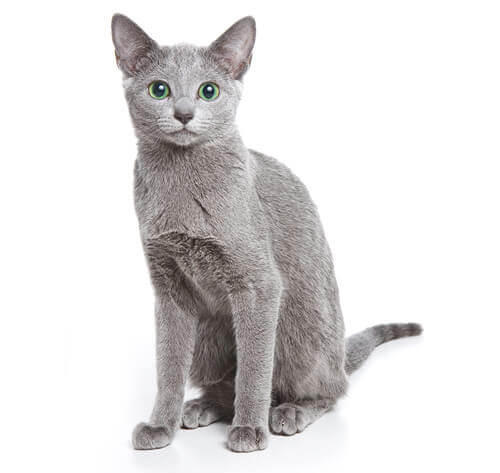
The Russian Blue is easily distinguished with her emerald green eyes and silver-tipped blue coat. Though naturally shy, this feline is affectionate toward her family and gets along well with older children. Highly intelligent, the Russian Blue has been reported to open doors. This clean, quiet-mannered cat thrives in a consistent, routine environment. The Russian Blue is a healthy breed that does well when left alone for long periods.
DID YOU KNOW? The Russian Blue is believed to have descended from the royal cats of Russian czars. The breed has been known by several names, including Archangel Blue or Archangel Cat, since it is believed to have originated in Russia’s port city of Arkhangelsk on the White Sea. Other names are Spanish Blue, Foreign Blue and Maltese Blue.
The need-to-know
- Highly active and inquisitive cat
- Sociable and dependent cat
- Quiet cat
- Lean and elegant cat breed
- Requires grooming once a week
- Non hypoallergenic breed
- Needs some out-door space
- May require familiarisation before living with children
Personality

Russian Blue cats are quiet and sensitive, sometimes shy and reserved but are said to be tremendously loyal to their chosen human being. They may be cautious of strangers and take time to develop a friendship with humans. Once settled in a loving environment they love to play with toys and enjoy jumping, climbing and racing around and are extremely agile and light footed.
History and Origins

Country of Origin: Russia
The Russian Blue cat was originally known as the Archangel Cat because it was said to have arrived in Europe aboard ships from the Russian port of that name (Arkhangel'sk). It has also been known as the Spanish Cat and the Maltese Cat, particularly in the US where the latter name persisted until the beginning of the century. There is, however, strong evidence linking the cat with Russia. Large numbers of cats with similar coat colours are found in Scandinavia and their dense coat is indicative of living in a northern climate. Although blue is considered the typical colour of this breed, black and white Russians are known. These colours arose during World War II when the few remaining Russian Blue cats were crossed with the British Blue and the Siamese to maintain numbers.
Nutrition and Feeding

Every cat is unique and each has their own particular likes, dislikes, and needs when it comes to food. However, cats are carnivores and every cat must obtain 41 different and specific nutrients from their food. The proportion of these nutrients will vary depending on age, lifestyle and overall health, so it's not surprising that a growing, energetic kitten needs a different balance of nutrients in her diet than a less active senior cat. Other considerations to bear in mind are feeding the right quantity of food to maintain 'ideal body condition' in accordance with feeding guidelines and catering to individual preference regarding wet or dry food recipes.
Other Information

Health and common issues
The Russian Blue cat breed seems to be healthy.
Best cat breeds for children
While this breed is not widely recognised as one of the best breeds for children, all cats are different and with the proper familiarisation may still be able to live with children.